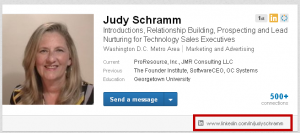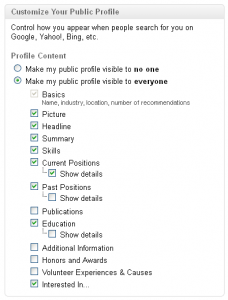People looking for you often begin with a search engine. If you have a LinkedIn profile, it will most likely show up as one of the top results anytime someone searches for you by name. The good news is that you can control how your LinkedIn public profile appears to the public whether they’re logged into LinkedIn or not.
You can hide your public profile to prevent it from showing up in search. However, it’ll be harder for prospects, potential partners and future employees to find you. They’re not going to work harder than they have to. Compromise by making your profile visible to everyone while controlling the sections you wish to hide or make visible.
To see how your public profile looks, go to your customized LinkedIn URL, such as www.linkedin.com/in/judyschramm. (Your profile lists your URL as Figure 1 shows.)
Figure 2 displays the fields you may want to display at a minimum. Still it depends on why you use LinkedIn and the information you’re willing to share with the public.
For each field, ask yourself if you want someone who may or may not know you to see this information before connecting with you.
Here are the recommendations for each field.
Picture: Your photo lets people know they’ve reached the right person and adds authenticity. There are very few people who would have a good reason for not including a photo. Given that LinkedIn’s own stats show that profiles with photos are 7x more likely to be viewed, making your photo visible should be an easy decision.
Headline: The LinkedIn professional headline quickly communicates who you are and may compel them to keep reading.
Summary: This is your professional story. People tend to relate more to the LinkedIn summary than with a bulleted list of job responsibilities and accomplishments. If you choose not to display the details of your current and past positions, the summary makes a good stand-in.
Skills: People can quickly learn what your specialties are based on this list and the number of endorsements for each. If you don’t have many endorsements in the skills that matter to you, it may be best to hide this field until you rack up more. You can also control which skills and endorsements to display.
Current positions: What you’re currently doing affects whether someone wants to connect with you. For example, a business owner would want prospects to know about the business and what problems it solves in hopes viewers will want to do business. If you turn off “show details,” then people can only view your company name, job title and employment dates.
Past positions: Displaying the company name, job title and dates worked highlights the types of companies you’ve worked for and your career progress. It should be enough to tell your story without divulging too much information.
Publications: Some positions, such as college professors and professional writers, will want to list publications. Being a published author shows you have respected expertise and strong writing skills.
Education: Even if you’ve been out of college for more than 20 years, including your educational credentials helps classmates find you. Prospects who are fellow alumni will be excited to see you have education in common. (Hoya Saxa!) It strengthens the connection.
Additional information: This includes interests, birthdate, marital status and advice for people who want to contact you. One reason you might display this field is for the contact information. The rest is too personal, but you can control who can view your month and day of your birthday, year of birth and marital status.
Honors and Awards: Deciding whether to display this depends on what honors you’ve listed and your LinkedIn goals. This may not be information people need to know when searching for you. Some honors and awards reveal personal information. For instance, if you received an award from PTA, people will know you are most likely a parent.
Volunteer Experiences and Causes: People belonging to political or other sensitive organizations may want to hide this information or omit it altogether. Like honors, your organization can reveal personal information about you that you don’t want strangers to know.
But charity work strengthens connections, gives some additional promotion to the charity, and lets others see that you give back. So it might be something you want to share.
Interested In: This helps people know whether it’s worth contacting you. To update this, select “Communications” in “Privacy and settings” and then “Select the types of messages you’re willing to receive.” Of course, if you’re open to career opportunities and you don’t want your current company to know, then you’ll want to turn this off.
Here’s what logged-in LinkedIn users can or can’t view in your profile:
- Connections can view your name and profile.
- Some premium members can see your full name and profile if you allow InMail messages.
- Members outside your network only see an abbreviated profile without your name.
- First-degree connections and people you’ve emailed who have added you to their LinkedIn Contacts can see your email address.
- Third-degree connections and fellow Group members with free accounts will only see your first name, last initial, and the top section of your profile when doing a keyword search. One exception: They can see your full profile when searching by first and last name.
What if you want to prevent someone from viewing your profile? You can’t. But if you do, it requires doing the following — which isn’t likely worth the sacrifice:
- Hide the public version of your profile.
- Hide your profile photo.
- Change your profile display name.
In short, the more you reveal, the more likely people will connect and engage with you.
What are your recommendations for managing your LinkedIn public profile settings? Also, please share your questions in comments so we can find an answer for you.


